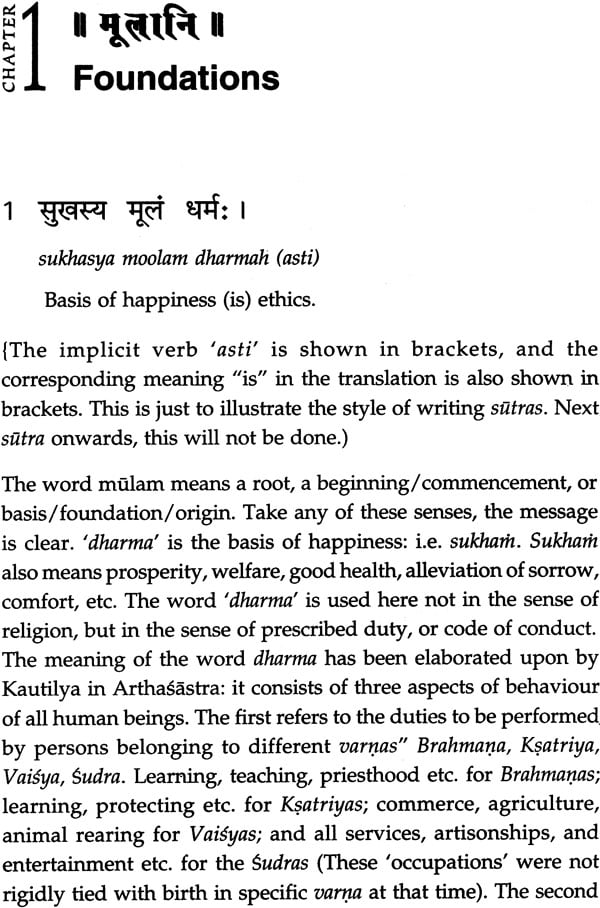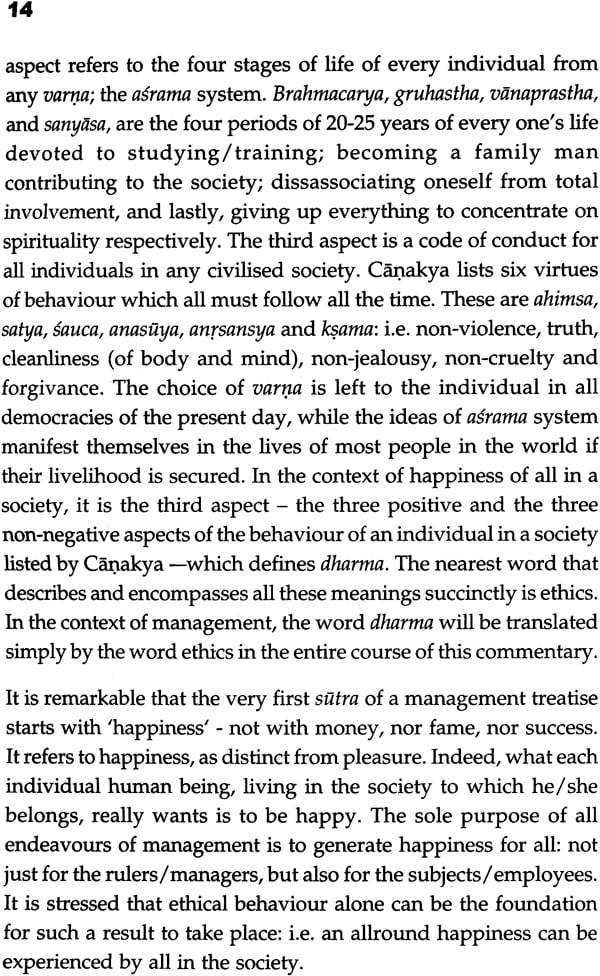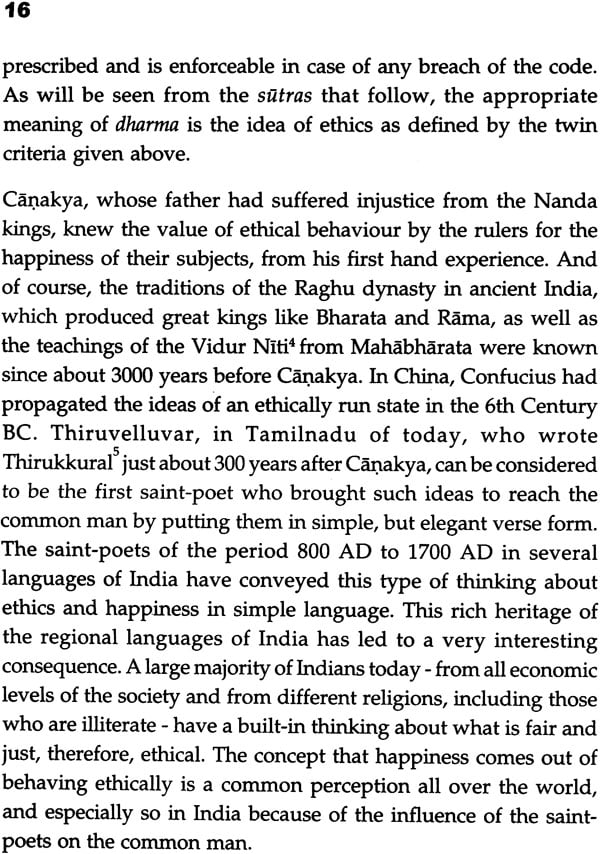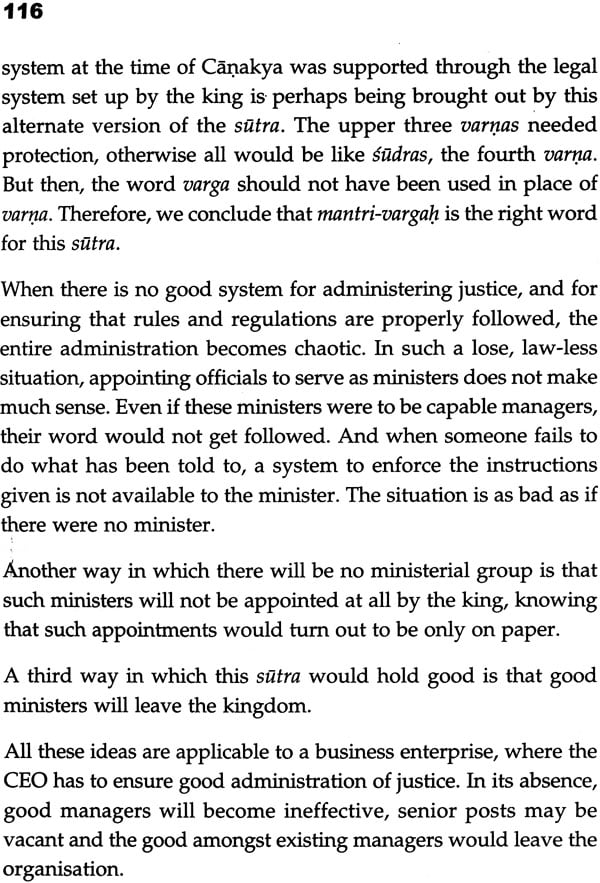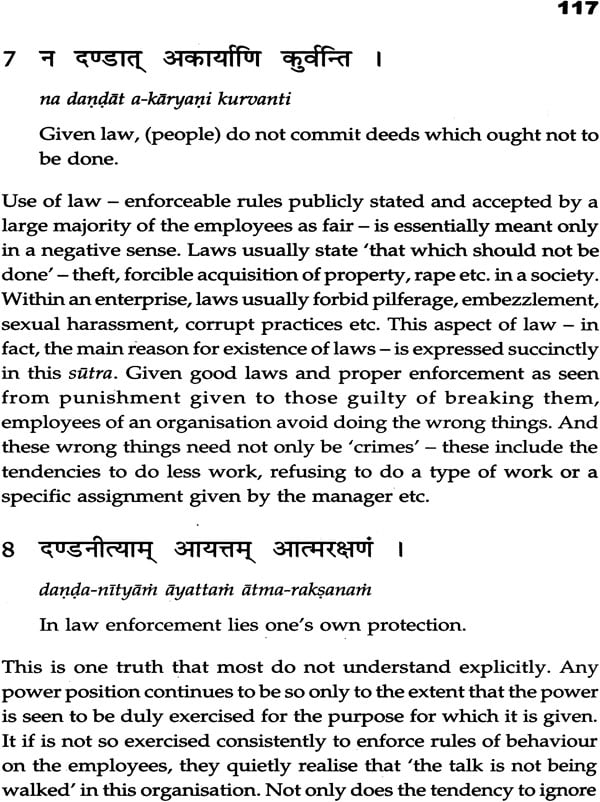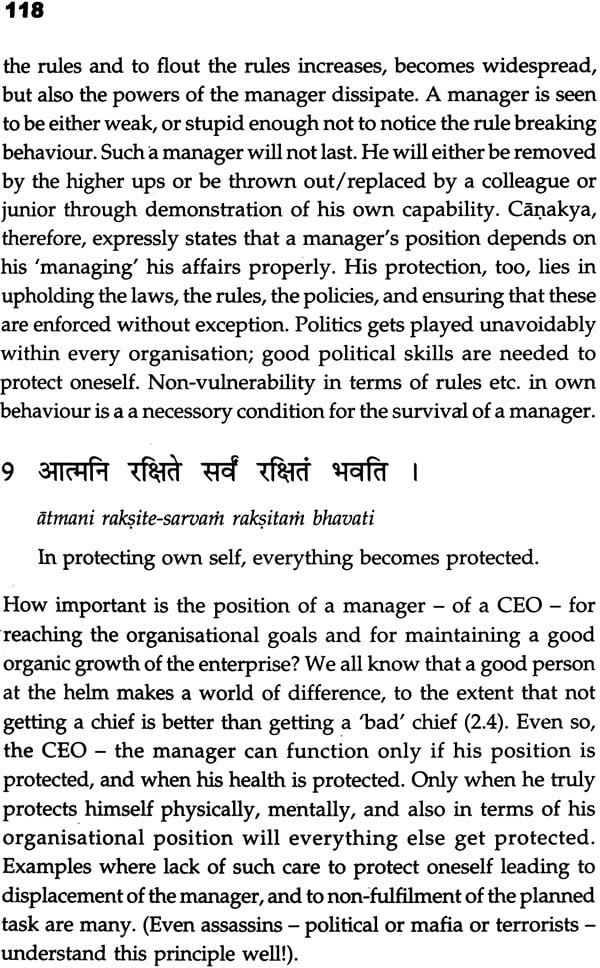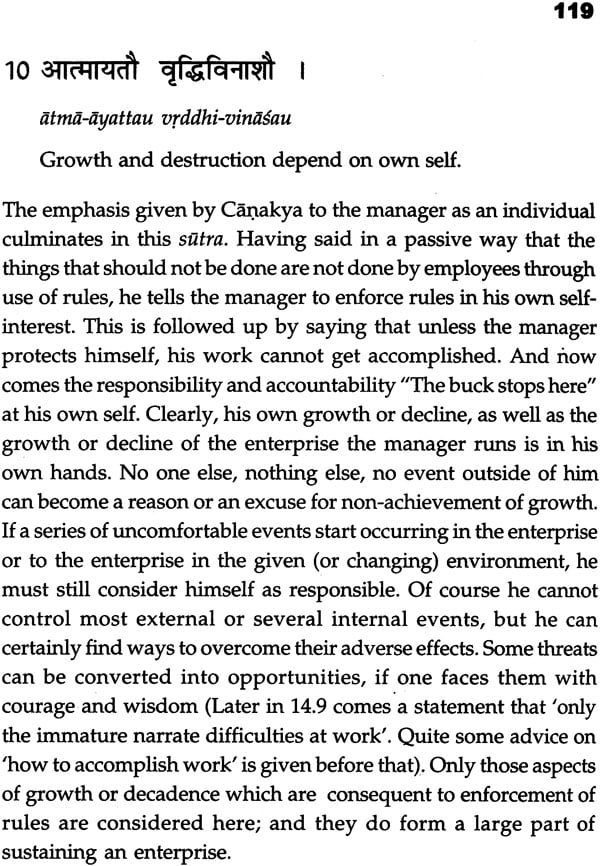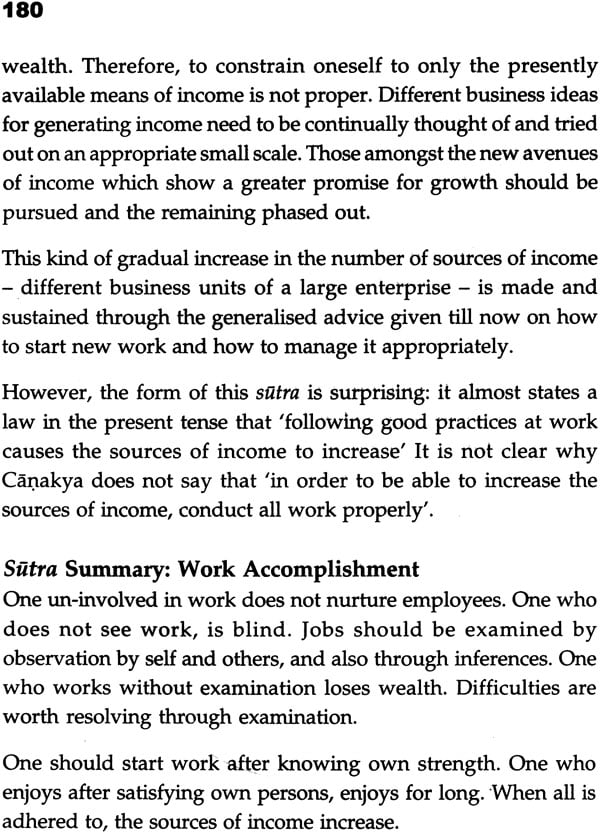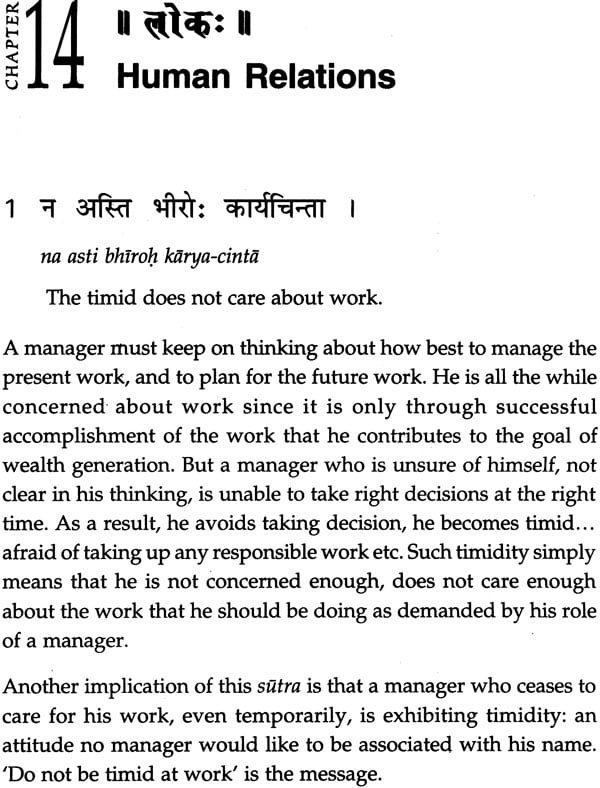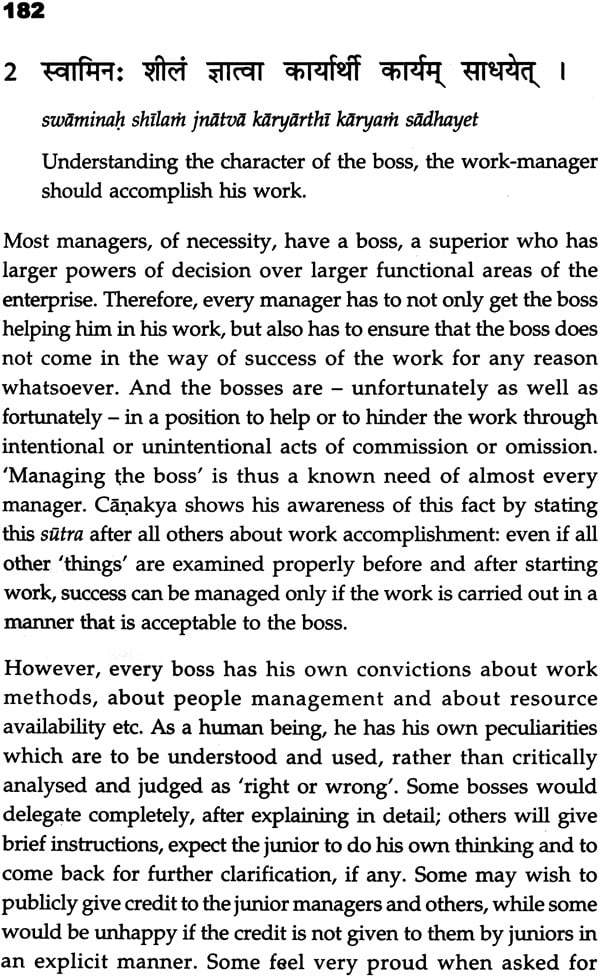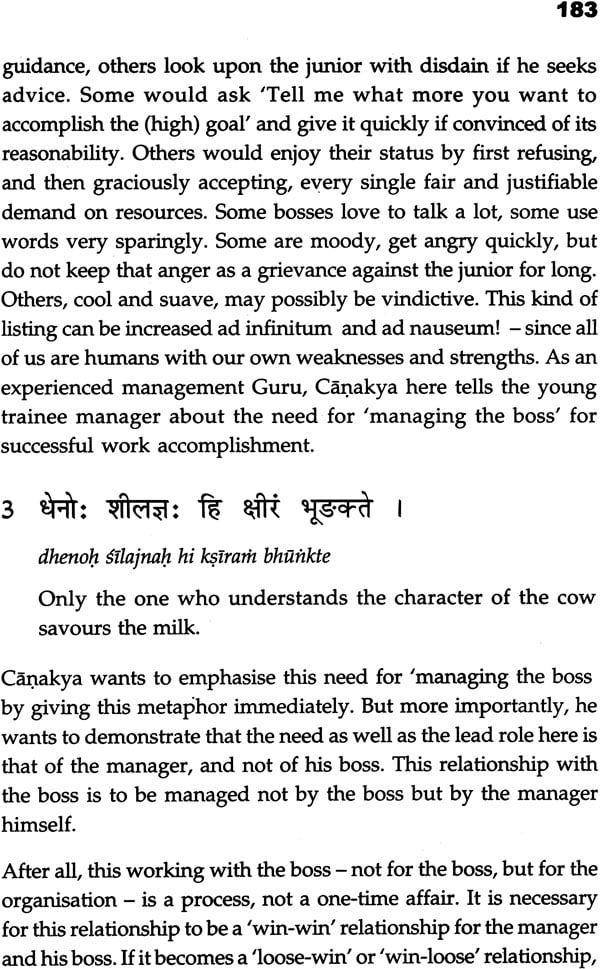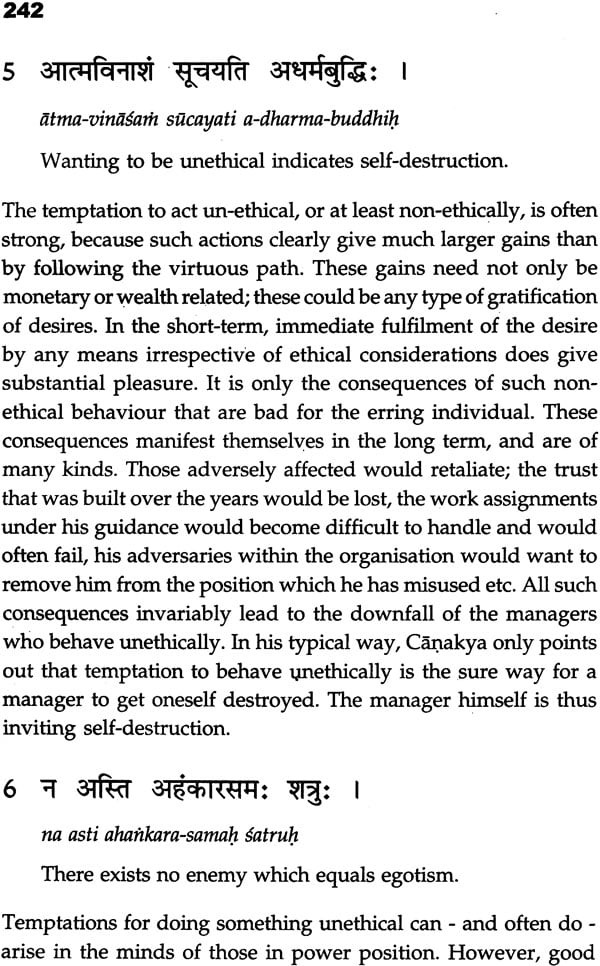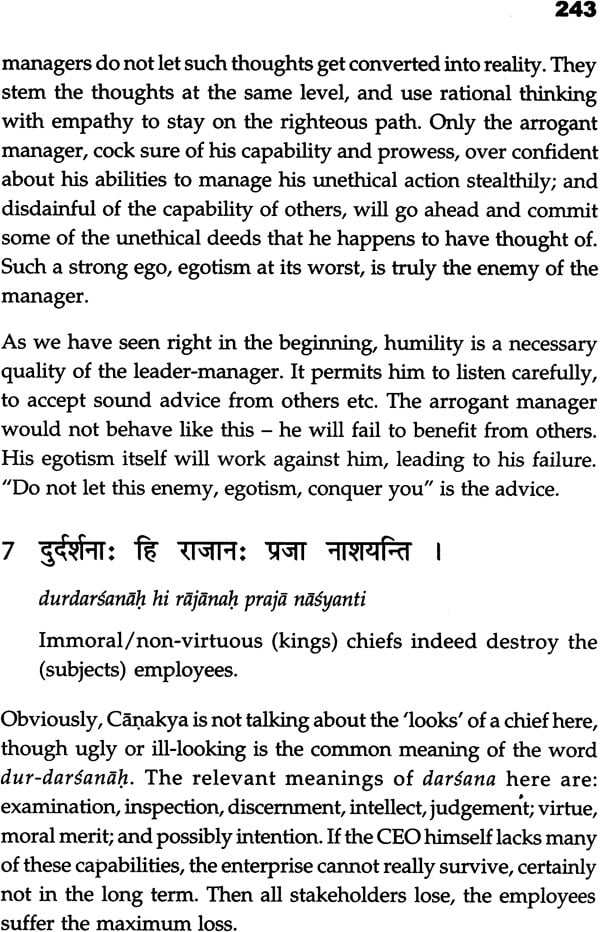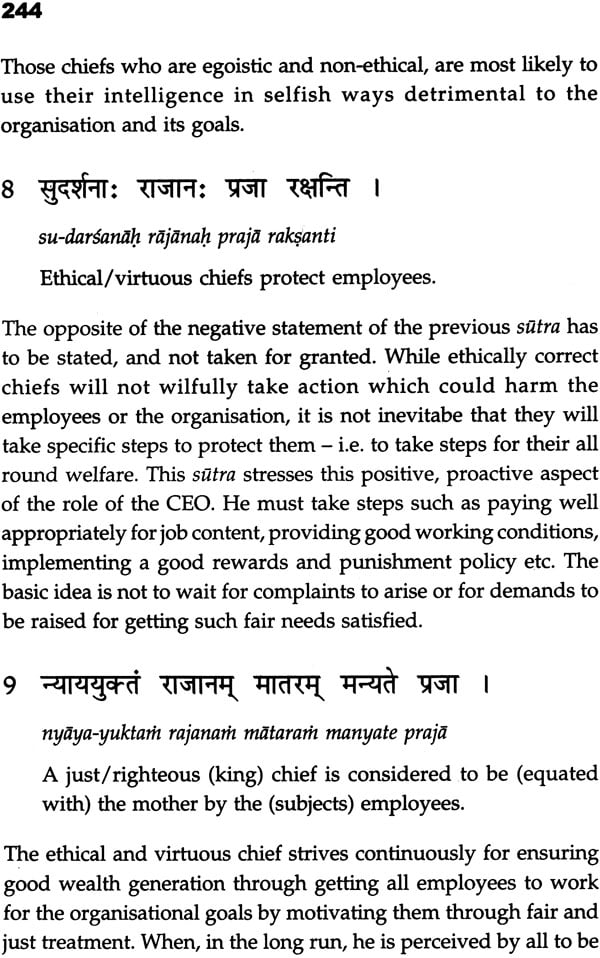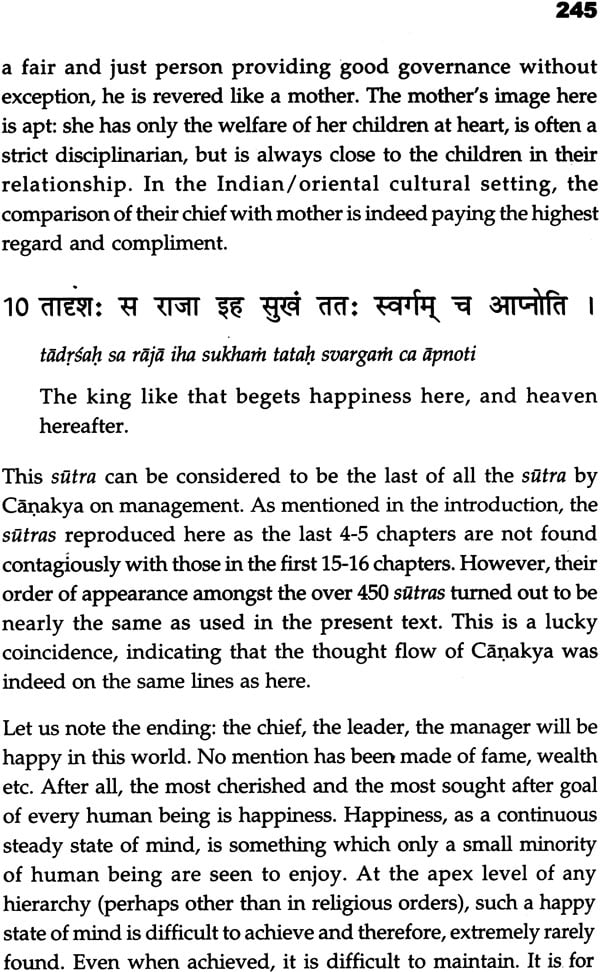
Canakya On Management
Book Specification
| Item Code: | NAG457 |
| Author: | Ashok R. Garde |
| Publisher: | Jaico Publishing House |
| Language: | Sanskriy Text with English Translation |
| Edition: | 2011 |
| ISBN: | 9798179924081 |
| Pages: | 280 |
| Cover: | Paperback |
| Other Details | 8.5 inch X 5.5 inch |
| Weight | 340 gm |
Book Description
About the Book
Canakya's Arthasastra deals with the different aspect of managing a kindgdom, including management of men. The principles contained in Canakya's work have the unique distinction of being used successfully in practice to achieve good result on a sustainable basis.
The management principles used in the USA or in Japan are derived from their own cultural background. There exists enough evidence to show these system, even when meticulously and earstly adopted in India, rarerly take roots or produce the desired results. We need to look for those principles that make sense in our own social and work culture and which whould hopefully deliver better results for all concerned the customer the investors, the employees and the society. This book on the management philosophy and practice of canakya is the author's earnest attempt to help Indian readership to become familiar with the great work of the First Total Management Guru of the world
About the Author
After obtatinig a degree in textile technology from the University of Bombay Ashok Raghunath Garde joined ATIRA (Ahmedabad Textile Industry Research Association), where he served for over 3 decades. In 1990 he was appointed CEO of ATIRA. Mr. Garde has been awarded the Fellowship of the Textile Institute, UK, the Honorary Felloship of the Textile Association. India, and the Fellowship of the Gujarat Sciece Academy
Foreword
It is nearly 30 months since I first read Prof. Ashok Garde's illuminating text titled "Canakya's Aphorisms on Management". Many will know Canakya as Chanakya, who was the mentor of the great Emperor Chandragupta Mourya of the 4th Century BC.
I then thought that the Business Schools should have it in their Library. Business School teachers are sure to find materials in it to support some presentation or the other on whatever subject is their prime concern.
I shall not comment on the contents except exhorting that whoever comes across this book should quickly read the "Introduction" because it succinctly describes its value to the reader. It may often result in that person wanting to own a copy for a serious reading.
I am glad that "Jaico Publishing House" is undertaking to popularize these Aphorisms amongst people all over India and abroad. Hopefully they shall aggressively promote its readership by encouraging the prestigious Business Schools such as the IIMs of India and the Ivy League B-Schools of USA and top Schools of Europe to order more than one copy for their library, because it is likely to be simultaneously used by several Professors and students.
In his introduction, the author has repeatedly referred to the book's utility to the CEO. I believe it will be useful for Managers at all levels and also the aspiring Managers. HR Managers should seriously consider procuring copies for study by their various functional heads. They can extract what appeals most to them for application in their area and having a "discussion" meeting with their peers or their reportees.
Mr. Ashok Garde was interviewed and selected by Dr. Vikram Sarabhai for the A TIRA job as a Scientist. But he soon learnt the art of management just as Dr. Vikram Sarabhai, a Scientist himself, became a highly successful Management Professional, who left his impact not only in the Private and Public Corporate organizations he served but also motivated people like Mr. Garde to become a great supporter of the Management movement in Ahmedabad. When AMA (Ahmedabad Management Association), founded by Dr. Vikram Sarabhai, proposed that ATIRA provide AMA a part of its spare land for housing the AMA Training and Development Center for the Working Managers and shared AMA's vision of making it the role model for various Local Management Associations (LMAs), who were members of the All India Management Association, Mr. Garde helped to work out a Win-Win situation for ATIRA, (whose Director he was), AMA and the people of Ahmedabad. Jaico may find the LMAs a useful means of popularizing the very valuable Management insights provided in this book.
Foreign Executives doing business with or in India do like to read about Indian culture and ethos. They will find. this book interesting and will readily buy it but (and it is a big 'but') the question is that how will they know about the book and how can they easily get it. I do hope Jaico will work on seeing that it is available on the internet.
The author has written the sutras in the Sanskrit Devanagari Script and also in phonetic English script. If a reader pursues the book frequently he may find himself understanding several Sanskrit words. He or she may then read Panchatantra and Hitopadesa looking for morals for use In today's world of Management situation.
Today, as never before, more and more businessmen and Management gurus are talking about the importance of ethics, which, since time immemorial, the Indian thinkers and businessmen have highlighted as a must to be practiced in business and everyday conduct calling it "the arthashastra dharma" This "Dharma" has nothing to do with "religion" as is generally understood. Chanakya has a lot to say about the ethics and good governance In India, the legendary Chanakya invokes respect bordering on awe. To scholars outside India, he is better known as Kautilya. He is the author of a full treatise on Governance. He practiced what he taught nearly 2400 years ago. He trained Chandragupta Mourya to be a fair, just and efficient Chief Executive Officer of a kingdom. His dynasty succeeded in making India attain great heights in all fields, with the Greek Commander in Chief of Alexander, the Great, getting his daughter married to Chandragupt Mourya.
Mr Garde has painstakingly brought out the manifold implications of each sutra. Experienced managers will note that many a sutras succinctly state a principle underlying their own experiences, but which they did not 'see' in that light before! The philosophical underpinning of managerial actions any action as propounded by Chanakya have been well brought out by the author. Consequently, those managers who work towards internalizing use-worthy sutras can become high achievers without being highly stressed by work.
With over 45 years of experience in top management and entrepreneurship, I feel that the ideas of Chanakya are worth following today, especially when adhering to the ethical path is the only 'mantra' to ensure long term survival and growth of an enterprise in a fiercely competitive globalised market. I hope that this book reaches a large number of managers in India and abroad' and they benefit from it.
Preface
Some management thinkers in India were looking for an Indian ethos in management, since neither the American nor the Japanese styles seemed to fit well into the Indian culture. I made a small attempt to look at Pancatantra, the world's first documented training programme for top management. Thereafter, I came across several popular Hindi versions of Canakya Sutras. Many appeared to be incorrectly interpreted, but quite a few were startlingly insightful and usable for guiding managerial actions.
By 1994, in the 4th year as the CEO of ATIRA, I started picking up a few sutras and. using them as guide rules. Not all sutras are principles of management. Many are like 'laws of behaviour at work', indicating 'what will happen when' with a high probability. The flow of ideas is very different from the management thoughts of 1950s. In some ways, the total thought process is akin to the management thinking in the late 20th century, which includes 'what managers should be, rather than only 'what managers should do'. The idea that the manager should manage himself well on the emotional front has been seeping in gradually in the recent past.
The Indian ethos is visible all along in Canakya Sutras, and most concepts are meaningful in our current cultural context. This realisation led me to think of writing a commentary on Canakya Sutras from the management point of view. This desire was consistently reinforced by Shri KK Nair, Executive Director, AMA and Dr. Balabhaskaran, Dean, ICFAIAN Business School, Ahmedabad.
I am grateful to Shri Rajesh Mehta, President, AMA, and to Shri KK Nair for their decision to publish this work as an AMA publication. If the management personnel in India -the 'would be managers' and those practicing management professions at different levels -who read this book do just TWO things, the efforts of the author and of AMA will stand justified:
One: Discover a rather different way of looking at management. Two: Check out which of these 216 aphorisms fit their experience.
If few of the readers do a Third -i.e. use selected sutras for guiding their actions -that would be great.
Introduction
Management of people and of resources, whether for manufacturing products, or for providing services, or for administering a state, is a rather complicated task. Not surprisingly, therefore, we find that a plethora of sets of generalisations have been developed on "How to Manage Well to Achieve Excellent Results on a Sustainable Basis." Only a few of these have been total systems covering all the aspects of managing a business. Many have been applied to real life situations and used, but not necessarily well documented. The real test of a treatise on management is not just its completeness or just the beauty of its logic, but also the demonstration of its practical application in real life situations, with enduring success.
The well educated Indian, like his counterpart in the Western and now also in the Eastern world, is under the implicit impression that such systematic thinking on management started only in the 20th century. However, given the complexity of managing a kingdom or a country, it would not be surprising if treatises on management were written in the ancient past also. In fact, a search for such management literature in India and in the world yields fruitful results. Some of the well known works that deserve our attention are the following, listed in chronological order.'
Management: The Indian Ethos
The Pancatantra consists essentially of 69 case studies compiled by the Guru to teach "management of people" to three grown up sons of a king in a six-month residential training programme. Hitopadesa is a similar treatise, that borrows heavily from Pancatantra, and has an identical narrative style. But unlike Arthasastra, these two deal only with one aspect of management -managing people. Canakya's Arthasastra deals with all the different aspects of managing a kingdom, including management of mer., Arthasastra is the earliest known and available treatise of this kind in the history of the world. The Canakya Sutras are an abstraction of the principles of management on which the treatise is based. In Arthasastra, Canakya deals with all aspects of administering a state -from training and establishing a governing hierarchy, selecting people, and levying taxes, to laying down laws, to deciding punishments for breaking the law, etc. Incidentally, Canakya -also known as Kautilya -refers to views of several earlier (over 600 years) Indian authorities on management. He then states his own view, giving reasons for differing from the earlier views. One presumes that he wrote the Sutras with a view to make it easy for his students of management to remember the principles of management, in a manner that will prove useful in actual practice.
The Canakya Sutras have the unique distinction of being the principles which have been demonstrated to have been used successfully in practice to achieve good results on a sustainable basis. Canakya taught these principles to a group of youths, including Candragupta, and used this well trained group to overthrow the unjust and oppressive dynasty of the Nanda kings of Pataliputra, the capital of the country of Magadha. Candragupta established the Mourya dynasty, which ruled well for about 136 years, and produced a king like Samrat Asok (samrtit = great emporor). The successful installation of Candragupta, whose regime was fair and just, as opposed to the tyranny and partiality of the Nanda kings, is an eloquent testimony of the prowess of the management principles propounded by Canakya, These principles, the Canakya Suiras, therefore, deserve a careful study in the present context, when we are on the lookout for an Indian ethos in management. The management principles used in the USA or in Japan are obviously derived from their own cultural background. There exists enough evidence already to show that these systems, even when meticulously and earnestly adopted in India, rarely take roots or produce the desired results on a sustainable basis. We do need to look for those principles that are likely to make sense in our own social and work culture. These would hopefully deliver better results for all concerned -the customers, the investors, the employees, the vendors, and the society.
Several of the current attempts at developing an Indian ethos in management turn to our philosophical or religious texts. Such efforts, though commendable, suffer from three disadvantages. Firstly, the philosophical religious texts were written primarily in the context of doing one's ordained duties as an individual. Secondly, these do not address the many different aspects of managing an enterprise. Thirdly, when we choose the scriptures of anyone religion in India, the managers belonging to other religions find it really difficult to accept the concepts which are not to be found in the same form in their own religion. The basis for good management principles has to be secular and rational for universal acceptability. There exists no doubt that the principles propounded in Gita are useful for individual managers to mould their own character, and to strengthen it for dealing effectively with problems faced by the managers. These are so rational that these can be accepted secularly without attributing God-ness to Krsna. However, it is better to look at specifically management-oriented treatises like those cited above. From amongst these, the one complete system of looking at all aspects of management is the Canakya-Sutras.
The Sutra System
The Sutras system of teaching or dealing with any body of knowledge is a unique system developed and used since about 7000 BC in India. A Sutra is a short, pithy statement or an aphorism about a concept: it is easy to memorise, and to recall whenever required in practice. From Patanjali's Yogasutras" to Vatsyayana's Kamasutras, we see that the entire territory of the four purusariha has been covered by the sutras system: these are dharma, artha, kama, and moksa -duties/morals, resources/money, desires/sex, and salvation, respectively. The practicable knowledge and skills in each have been enunciated in the sutra form also, besides in the textbook form. Each word in any sutra is very carefully chosen.
Contenta
| Foreword | iii | |
| Preface | vi | |
| Preface to Second edition | vii | |
| Introduction | 1 | |
| Invocation | 11 | |
| Chapter 1 | Foundations | 13 |
| Chapter 2 | Counsellors | 35 |
| Chapter 3 | Policies/Projects | 48 |
| Chapter 4 | Management | 71 |
| Chapter 5 | Management Science | 80 |
| Chapter 6 | Alliances | 88 |
| Chapter 7 | Behaviour | 97 |
| Chapter 8 | Enforcement | 110 |
| Chapter 9 | Resources | 123 |
| Chapter 10 | Working | 131 |
| Chapter 11 | Work | 143 |
| Chapter 12 | Work Manager | 152 |
| Chapter 13 | Work Accomplishment | 171 |
| Chapter 14 | Human Relations | 181 |
| Chapter 15 | Managerial Actions | 192 |
| Chapter 16 | Wealth and Desires | 201 |
| Chapter 17 | Character | 211 |
| Chapter 18 | Faults | 218 |
| Chapter 19 | Enthusiasm | 223 |
| Chapter 20 | Own Person | 232 |
| Chapter 21 | Ethics | 239 |
| Sutra Listing | 247 | |
| Biblography | 256 |
